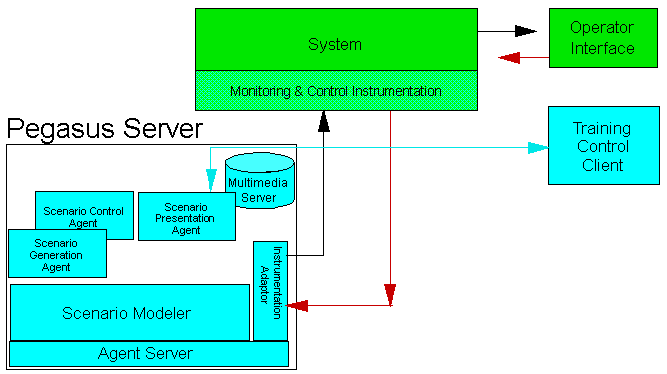

An operator of a complex system typically activates responses to emergent scenarios and coordinates the interpretation of the scenario and the responses with other individuals involved in the operations of the system. The problem of training, in its broadest form, is that of teaching operators to activate the best responses to emergent scenarios and pursue the best coordination procedures.
A typical system for which embedded training is applicable is broadly depicted in the figure above. The system interacts with an external scenario through respective monitoring and control instrumentation of sensors (black arrow) and effectors (red arrow). It processes the scenario data acquired by the sensor instrumentation, presents it to operators (black arrow) and acquires their response control actions (red arrow) to handle respective actions on the scenario. For example consider a complex weapon system. The scenario to which the system responds is defined by a battlefield situation. Sensors acquire various parameters of the scenario, process these and display data to the operators of the system. The operators respond by activating certain functions which, in turn, cause effects on the scenario such as shooting a missile or a bomb.
In order to train operators, it is necessary to present to them simulated scenarios, acquire their responses and simulate their effects on the scenarios. These activities can be accomplished by incorporating embedded training software, as investigated by Pegasus. It is also necessary to evaluate operators responses, identify improvements and generate scenarios that improve operators performance.
The primary idea underlying the embedded training architecture is to augment the monitoring and control instrumentation of the target system with instrumentation to support training mode and then attach this instrumentation to the Pegasus training server. This permits the Pegasus server to access the instrumentation of the target system and (a) create simulated scenarios, (b) apply the operator responses to these simulated scenarios, and (c) enable dynamic monitoring and control of scenarios and operators activities.
The Pegasus server utilizes an agent services layer that support dynamic delegation of agent code. All software of the Pegasus server is constructed as delegated agents that can be dynamically dispatched to a Pegasus server and executed under local and remote control. The Pegasus server include an object-oriented scenario modeler repository. The scenario modeler maintains objects representing various components of a training scenario.
The scenario modeler interacts with the target system via respective instrumentation adapters. The target system can acquire scenario parameters or effect changes in the scenario via these adapters. The adapters acquire data and effect changes on the scenario modeler. The scenario modeler is accessible to a variety of agents executing at a Pegasus server. These agents can include scenario generation and control agents, created and dispatched by a training center as well as scenario presentation agents that are used to provide additional information to operators and trainers via training control client software.